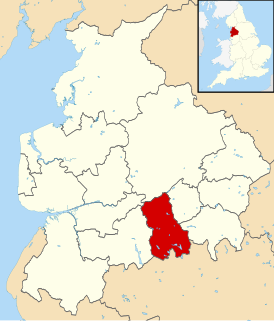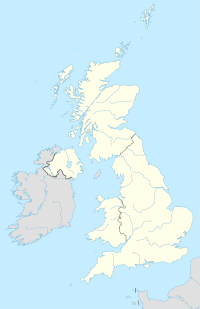
Blackburn with Darwen is a unitary authority area in Lancashire, North West England. It consists of the minster town of Blackburn and the market town of Darwen including other villages around the two towns. The population of the Unitary Authority taken at the 2011 census was 147,489.

The Borough of Burnley is a local government district of Lancashire, England, with the status of a non-metropolitan district and borough. It has an area of 42.7 square miles (110.7 km2) and a population of 88,527 (mid-2018 est.), and is named after its largest town, Burnley. The borough is bounded by Hyndburn, Ribble Valley, Pendle, Rossendale – all in Lancashire – and the borough of Calderdale in West Yorkshire. It is governed by Burnley Borough Council, which is currently under no overall control following the 2019 local elections.
Strategic health authorities (SHA) were part of the structure of the National Health Service in England between 2002 and 2013. Each SHA was responsible for managing performance, enacting directives and implementing health policy as required by the Department of Health at a regional level.
Polyclinics in England were intended to offer a greater range of services than were offered by current general practitioner (GP) practices and local health centres. In addition to traditional GP services they would offer extended urgent care, healthy living services, community mental health services and social care, whilst being more accessible and less medicalised than hospitals. A variety of models were proposed, ranging from networks of existing clinics to larger premises with several colocated general practitioner (GP) practices, more extensive facilities and additional services provided by allied healthcare professionals.

The National Health Service (NHS) is the publicly funded healthcare system in England, and one of the four National Health Service systems in the United Kingdom. It is the second largest single-payer healthcare system in the world after the Brazilian Sistema Único de Saúde. Primarily funded by the government from general taxation, and overseen by the Department of Health and Social Care, the NHS provides healthcare to all legal English residents and residents from other regions of the UK, with most services free at the point of use. Some services, such as emergency treatment and treatment of infectious diseases, are free for everyone, including visitors.
NHS West Midlands was a strategic health authority (SHA) of the National Health Service in England. It operated in the West Midlands region, which is coterminous with the local government office region. It was abolished in April 2013.
NHS North West was a strategic health authority (SHA) of the National Health Service in England. It operated in the North West region, which is coterminous with the local government office region.

East Lancashire Hospitals NHS Trust is an NHS hospital trust in Lancashire, England. It was formed in April 2003, as the result of a locally controversial, cost saving merger of Blackburn Hyndburn & Ribble Valley (BHRV) NHS Trust and Burnley Health Care NHS Trust, first announced in September 1999.
Bradford and Airedale Teaching Primary Care Trust is the name of the publicly funded healthcare system which serves City of Bradford and Airedale in West Yorkshire and is part of the NHS. The tPCT governs healthcare services in the area and like most NHS services, the majority of services are free at the point of use. It was abolished in April 2013.
NHS West Essex was a NHS primary care trust (PCT) in Essex, England. Formed in October 2006 following the merger of the three previous primary care trusts - Epping Forest, Harlow and Uttlesford, it has an annual budget of £370m. It covers approximately 390 square miles (1,000 km2), from Buckhurst Hill to Steeple Bumpstead with a population of about 280,000. It is responsible for improving primary care and the health of the local population and with a statutory responsibility for providing health services.
NHS Birmingham East and North was an NHS primary care trust (PCT) that was formed on 1 October 2006 following the merger of Eastern Birmingham PCT and North Birmingham PCT. PCTs were abolished in April 2013.
Prison healthcare is the medical specialty in which healthcare providers care for people in prisons and jails.
Low-threshold treatment programs are harm reduction-based health care centers targeted towards drug users. "Low-threshold" programs are programs that make minimal demands on the patient, offering services without attempting to control their intake of drugs, and providing counselling only if requested. Low-threshold programs may be contrasted with "high-threshold" programs, which require the user to accept a certain level of control and which demand that the patient accept counselling.
Healthcare in the city of Bristol, England and the surrounding area is largely provided by the National Health Service (NHS), through the Bristol Clinical Commissioning Group. Facilities include a large teaching hospital – Bristol Royal Infirmary – which offers nationally commissioned specialist cardiac, cancer and children's services from its city-centre campus to patients in the southwest of England and beyond.
Infectious diseases within American correctional settings are a concern within the public health sector. The corrections population is susceptible to infectious diseases through, exposure to blood and other bodily fluids, drug injection, poor health care, prison overcrowding, demographics, security issues, lack of community support for rehabilitation programs, and high-risk behaviors. The spread of infectious diseases, such as HIV/AIDS and other sexually transmitted diseases, hepatitis C (HCV), hepatitis B (HBV), and tuberculosis result largely from needle-sharing, drug use, and consensual and nonconsensual sex among prisoners. HIV/AIDS and hepatitis C need specific attention because of the specific public health concerns and issues they raise.
Healthcare in the West Midlands is now the responsibility of five Clinical Commissioning Groups (CCG): Birmingham and Solihull; Sandwell and West Birmingham; Dudley; Wolverhampton; and Walsall.
Healthcare in Lancashire is now the responsibility of 7 Clinical Commissioning Groups covering Blackpool, Chorley and South Ribble, East Lancashire, Fylde and Wyre, Greater Preston, Lancaster North and West Lancashire. From 1 April 2017 32 GP practices from Cumbria Clinical Commissioning Group will merge with Lancashire North CCG to form Morecambe Bay CCG.
Healthcare in Northamptonshire is now the responsibility of Northamptonshire Clinical Commissioning Group, with some involvement of Cambridgeshire and Peterborough CCG.
Healthcare in Lincolnshire is now the responsibility of five Clinical Commissioning Groups covering Lincolnshire West, Lincolnshire East, North East Lincolnshire, North Lincolnshire and South Lincolnshire.





